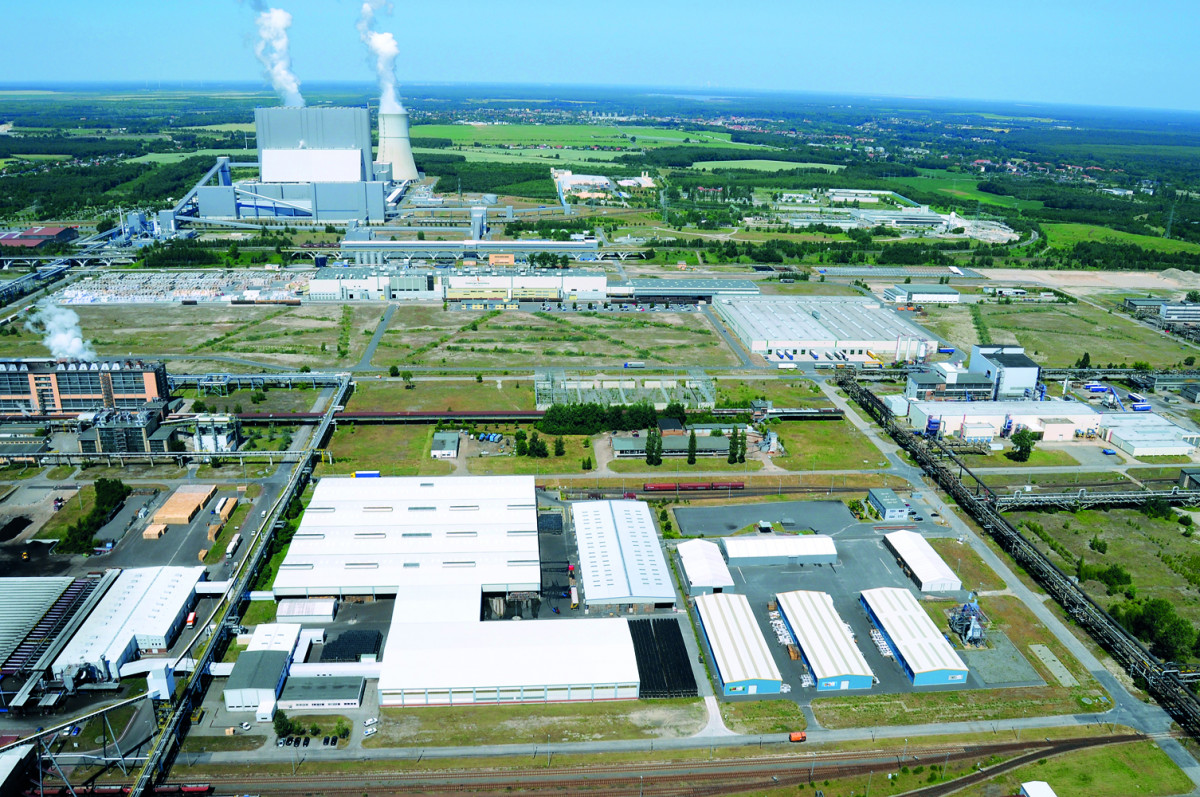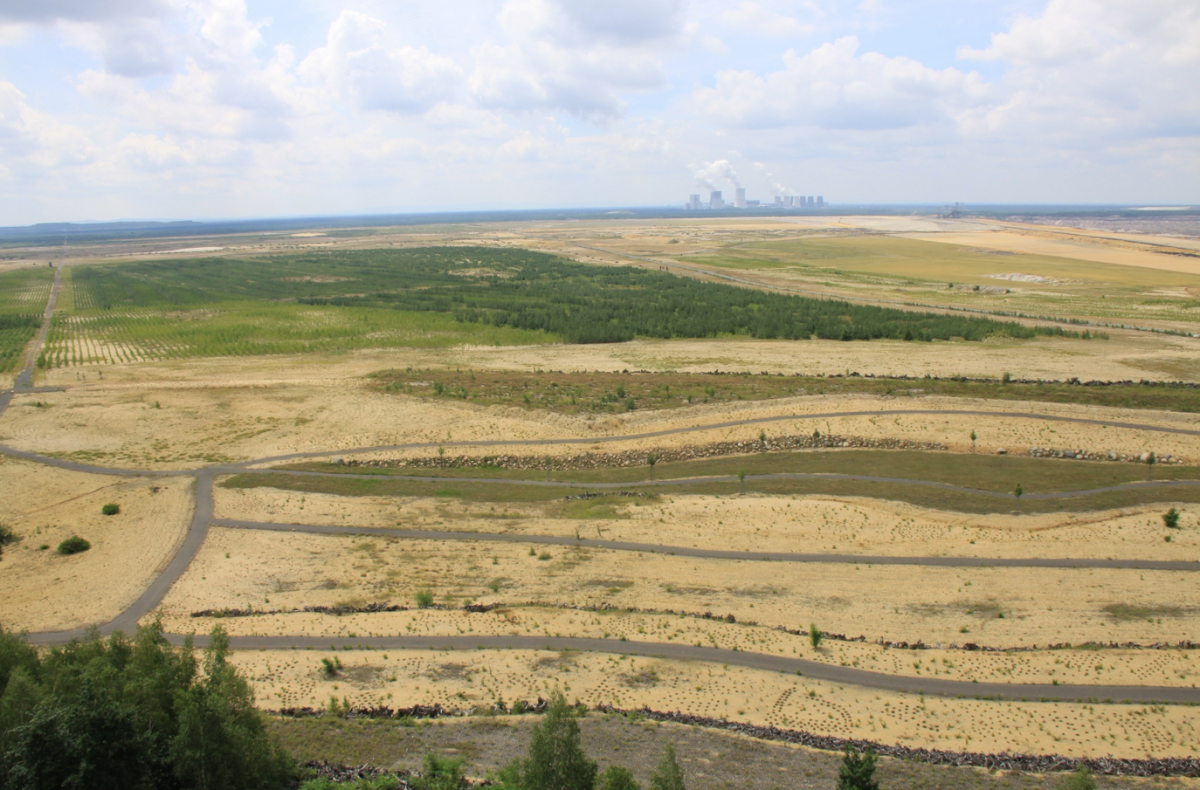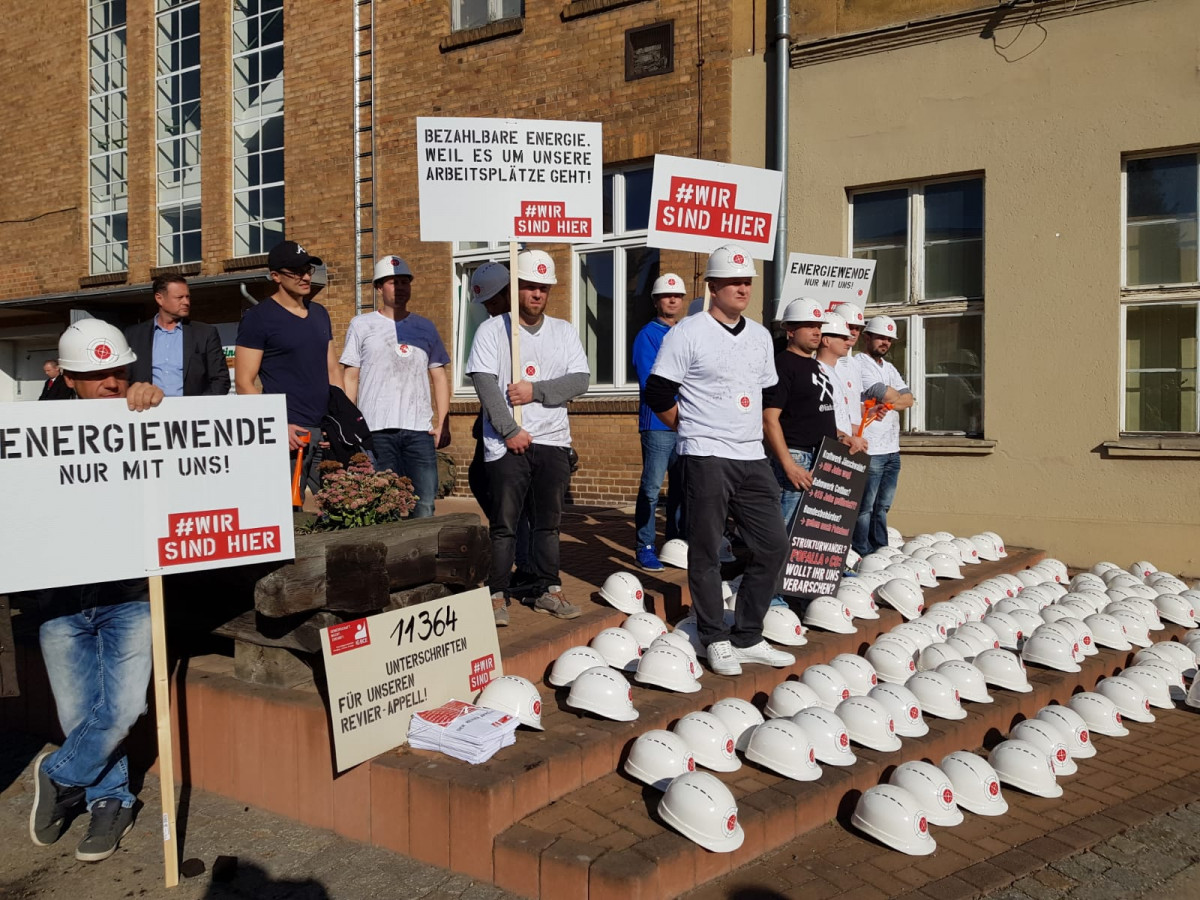East German state elections pose litmus test for coal exit plans
“You have to offer something concrete,” says Christine Herntier, the mayor of Spremberg in Brandenburg. “And the concrete thing for Spremberg, for my city, is that we are betting on hydrogen. In the next 20 years, it will be about building something new, but something still focused on energy. And then the region will do well too.”
Few people spend more time thinking about Germany’s coal exit than Herntier, who was also a member of Germany’s “coal exit commission”. Spremberg is a town in eastern Brandenburg, about 30 kilometers from the Polish border and just next to Schwarze Pumpe, a lignite power plant that emits the sixth highest amount of carbon dioxide of any power plant in Europe. Herntier says that 2,000 of her constituents, about 10% of the population, work in coal. She makes it clear, however, that she sees both the opportunities and the challenges presented by the energy transition in Germany. In this regard, she is emblematic of her entire region and indeed the country.
Polls suggest that climate protection was the most important issue for German voters in May’s European elections, in which the Green party achieved its best ever result nationwide, a close second to the Christian Democratic Union (CDU). On the other hand, the climate-denying AfD also reached new heights, coming first in Herntier’s Brandenburg and neighbouring Saxony, eastern coal states where the Greens did relatively poorly. This polarisation comes in the context of Germany, once a climate protection trailblazer, admitting it will miss its climate targets for 2020. Under pressure from both the Greens and the AfD, the ruling CDU-SPD coalition is working on a comprehensive climate action law, debating carbon pricing, and preparing to implement the coal exit that so concerns the coal miners of Spremberg.
Coal plays key part in region's identity
Two of Germany’s three major coal mining regions are in Saxony and Brandenburg. The Lausitzer Revier in the region of Lausitz, or Lusatia, extends across Brandenburg and Saxony and into neighbouring Poland. The Mitteldeutsches Revier, or Central German Mining District, is located in Saxony and Saxony-Anhalt.
These regions contain huge power plants that have a massive impact on the climate. Including Schwarze Pumpe, four of the top 10 CO₂ emitters in Europe are eastern German lignite power plants, according to climate think tank Sandbag. This helps explain why Brandenburg has the highest CO₂ emissions per capita of any German state.
Coal also plays a significant role in the local economy. The Federal Association for Lignite (DEBRIV) reports that some 8,200 people work in lignite in Lusatia and around 2,300 in the Central German Mining District. When indirectly dependent jobs are included—think of suppliers, cleaning staff, local restaurants—24,000 jobs in Lusatia are supported by lignite.
We are betting on hydrogen. In the next 20 years, it will be about building something new, but something still focused on energy. And then the region will do well too.
In some small towns, those jobs are vital. When German Environment Minister Svenja Schulze visited Schwarze Pumpe, she faced protestors in orange vests who accused her of “wanting to rob us of our future”. The country’s coal commission has recommended ending coal-fired power production by 2038; the government is now working to implement this goal and spur development in the affected regions by providing some 40 billion euros in structural support. Herntier says that among some residents, there is a “lack of understanding for the government’s [coal exit] decision… and a lot of scepticism about whether these new plans will really come off”.
It’s important, however, not to overstate the economic importance of this carbon-intensive energy source. Largely as a result of automation, mechanisation and a shift to renewables, the number of lignite workers has been falling for years, from over 120,000 in 1990, when Germany reunified, to fewer than 20,000 today, half of whom are aged 50 or older and will probably retire before the last plants close. There are over 2 million registered employees in Saxony and over 1.1 million in Brandenburg; 18,000 and 15,000 of them, respectively, work in renewable energy, according to a study forwarded to Clean Energy Wire (CLEW) by Saxony’s renewable energy agency.
Herntier emphasises the extent to which she sees the people of Lusatia as active players in the coal exit story. Economy minister Peter Altmaier just introduced a hydrogen technology initiative in July. In Spremberg, however, “where we have a coal-fired power plant and a mine, we have been focusing on hydrogen for three years […]. We hope that we get support from the state government,” says Herntier. The federal government has already said it will be putting up funding.
Indeed, the economic pain of the planned coal plant closures will mainly be felt at the household level. The web of personal connections to the industry makes it harder for environmental movements like Fridays for Future (FfF) to gain a foothold—teenagers are unlikely to take to the streets and demand their parents’ jobs be cut sooner. FfF spokesperson Luisa Neubauer tells CLEW that her organisation is “much weaker in [Saxony and Brandenburg]”. The student movement has called on its supporters to join protests for more climate action across Saxony and Brandenburg on the eve of the election on 30 August.

Polls support the idea that climate change is seen slightly differently in the eastern states. Ahead of the European election, Germans said that climate protection was the biggest challenge for the EU, whereas when the polling firm Civey and Spiegel Online asked Saxony and Brandenburg voters to pick their most important issue for the state elections, climate tellingly wasn’t an option. In another poll, 44 percent of residents in western Germany said that climate would define the political debate in the long term, compared to 35 percent of eastern Germans.
Josa Mania-Schlegel, a journalist with Krautreporter in the Saxon city of Leipzig, says that coal is also a key part of the local identity. “In the lignite regions, a lot of society is linked with coal. […] Energie Cottbus, the beloved soccer team, is sponsored by an energy company, as the name suggests. And there are movies about coal, like the recent one about [Gerhard] Gundermann, the famous East German singer who also worked as a coal miner.”
Alternative climate facts
The former East is fertile ground for scepticism about promises that renewable energy jobs are coming and support from Berlin and Brussels will make things better. The older coal miners lived through the “structural change” of the early 1990s, when the government of a reunified nation privatised, sold or closed scores of suddenly unprofitable eastern German firms; the economic chaos was only partly mitigated by the extension of the western safety net.
Thirty years after the fall of the Berlin Wall, GDP per capita in the East is 73 percent of that in the West. For years, young and educated Easterners, especially women, have departed in droves for the metropolises in the West, leaving behind ageing communities with shrinking tax bases.
The trend of East-West migration reversed for the first time in 2017, and the East does have vibrant cultural centres like Leipzig and Dresden. But as The Atlantic recently reported, eastern Germans remain severely underrepresented in high-level political and private sector jobs, even in their own region. One still hears complaints that “Ossies” (“Easties”) are treated like “second-class citizens”.
In this content, the right-wing AfD has emerged as a major force in what Germans often call the “new states”. Its posters and slogans for the 1 September elections seek to capitalise on Easterners’ frustration, calling on them to “complete the Wende”, i.e., the revolution of 1989 that led to the end of communism in the German Democratic Republic and the reunification of Germany.
It is working: the latest polls have the AfD tied with the CDU in Saxony at 26 percent. In Brandenburg, the AfD is alone in first place at 21 percent, with the Left Party, Greens, SPD and CDU all trailing by about five points. The populist AfD party is increasingly making climate denial a core part of its appeal. AfD leader Alexander Gauland accuses the surging Greens, his “main enemy”, of “destroying the country”.
In some ways, opposing climate action is squarely in the AfD tradition: if climate protection measures are not properly explained and paired with redistribution, they seem almost tailor-made to make the AfD’s target audience in the East suffer. A carbon tax would increase fuel costs for people who drive long distances across the rural landscape in a region with relatively poor public transportation and telecommunication services.
The party is doubling down on climate denial as the election approaches. In July, it released the “Dresden Declaration”, a remarkable document that invokes the legendary German scientist Alexander von Humboldt before asserting that no one has “proved” that CO2 emissions affect temperatures and climate protection measures are “expensive, useless … and endanger German prosperity”.
Other right-wing populist parties across Europe, such as the Brexit Party and the Swedish Democrats, espouse similar denialist positions, as detailed in a report by the adelphi think tank.
Of course, many people will cast their vote based on non-climate considerations, AfD supporters included: in fact, 37 percent of them see a need to act to protect the climate. Among the main issues in Saxony are laws regulating the detention of migrants before deportation and the state premier’s promise to hire 1,000 new police officers; in Brandenburg, commuters want better transport infrastructure, such as a second train line from Cottbus to Berlin to replace the one taken by the Soviets as reparations after World War II.
Even if polls suggest issues like migration and education are more important, AfD officials clearly believe that opposing climate action is a smart political move. Dominik Schäuble, a senior research associate at the Institute for Advanced Sustainability Studies in Potsdam, says that climate issues “probably aren’t winners at the state level because the strong expansion of wind energy, along with the coal exit, is seen rather critically in the affected regions”. Some rural Brandenburger are furious about the noise windmills make.

Blues, Greens, and those in between
That’s not to say that these states don’t have their own environmental movements. The only party in Brandenburg set to increase its vote share more than the AfD are the Greens, who are also on course to nearly double their 2014 result in Saxony. Professor Jan Schnellenbach, of the Brandenburg Technical University in Cottbus, says he hasn’t seen groups like Fridays for Future on campus, but the students who want to work in the energy sector are “realistic enough to know that the prospects for lignite are not good in the long term.” Accordingly, they are focusing on jobs in renewables.
The non-Green parties of the middle also acknowledge the need for an energy transition in a region that has recently suffered devastating forest fires. Saxony Premier Michael Kretschmer of the CDU recently said the German government was “frightening people” with new climate measures and taxes, but even he is satisfied with the coal commission’s recommendations. He has often referred proudly to the 40 billion euros affected regions are supposed to receive to support “structural change”. The SPD also backs the agreed coal exit timeline, Schnellenbach adds.
In any case, first place or not, the AfD will almost certainly not be in government in either state: all of the other parties, including the CDU, have ruled out entering a coalition with them. Saxony will have to go through difficult coalition talks to keep the extremists out of power—it could take a minority government or an unprecedented four-party coalition to do so.
Experts disagree about how the AfD’s denialism affects the climate positions of other parties. Mania-Schlegel says the party is holding back the climate debate, scaring off some centrist politicians from taking activist positions for fear of losing more voters to the far-right. Herntier argues that aggressive climate protection rhetoric risks driving voters towards “those who have no answer at all, who simply say everything should stay as it is.” Schäuble, for his part, believes that “it is clear to the large parts of the CDU that they won’t win back voters lost to the AfD by thwarting climate policy—and doing so would alienate voters in the middle.”
“It is clear to the large parts of the CDU that they won’t win back voters lost to the AfD by thwarting climate policy—and doing so would alienate voters in the middle.”
What impact?: states’ powers over power
State governments have a limited set of powers over climate policy in Germany’s federal system. State parliaments can toughen up federal climate standards and pass planning laws for renewables, such as rules for where wind turbines can be built. Schäuble says that the results of the coal commission, such as the recommendation for large structural change payments, “show that the lignite states have had significant political influence”.
Importantly, it is also state-level elections that determine the makeup of the Bundesrat, made up of the country’s state governments. This body can initiate legislation and veto certain laws passed by the national Bundestag.
The Bundestag, however, is the key actor in shaping German climate policy. National politicians determine Germany’s level of ambition at the European or international level. Whether the issue is an EU target of net-zero emissions by 2050 or the proper EU contribution within the Paris Agreement, the leader of Saxony has minimal direct influence.
So, should the federal government implement the recommendations of the coal commission, not even an AfD state government would be able to keep coal plants open past 2038. Nor—as Felix Ekardt, director of the Sustainability and Climate Research Unit in Leipzig and Berlin, points out—would a state government be able to quickly achieve carbon neutrality on its own without the right national and European policy framework.
Coal generation is collapsing in Europe, and it is unclear whether German lignite power plants made any profits in the first half of 2019. Ekardt says it is likely that even the “current, weak” EU Emissions Trading Scheme will take coal off the market before 2038. Nevertheless, elected officials would still have a big role to play in a world where coal quickly becomes unprofitable. In that case, the “structural change” in Lusatia would have to happen even faster.

National repercussions
One way these elections could transform German climate policy is by bringing down the governing CDU-SPD coalition.
Following a series of electoral defeats and the June resignation of former leader and grand coalition advocate Andreas Nahles, the beleaguered Social Democrats could decide to pull the plug on their cooperation with the CDU if they do poorly in Saxony and Brandenburg. The party will elect a new leadership duo over the coming months, to be confirmed at the national party convention in December. By that time, Thuringia, another eastern state where the AfD is on track to gain seats at the expense of the SPD (and CDU), will also have held elections.
Entering a third coalition with Chancellor Angela Merkel’s CDU was controversial from the start, with 34% of SPD members defying party leadership to vote against it in March 2018. The feeling was that, as a junior partner, the SPD had struggled to distinguish itself from the CDU in the past and was not getting credit for the progressive laws it pushed through.
With the SPD reaching new polling lows in 2019, a bad result in the eastern elections could be the last straw. According to the CDU-SPD coalition agreement, the parties should take stock of things halfway through the legislative period – that would be towards the end of this year. SPD politician Alexander Ahrens, a co-candidate for the party leadership, wants to take his party out of the coalition. In the eyes of prominent CDU figures like North-Rhine Westphalia Premier Armin Laschet, “no one can say whether [the coalition] will last until Christmas”. One argument for the SPD to stay is that many of its current MPs would probably lose their seats if they had to face another election. Some of their CDU colleagues would risk losing their jobs too.
The collapse of the coalition would open up a number of possibilities, as Politico lays out, and eventually pave the way for new elections—and thus, if the polls are to be believed, for a CDU-Green government, or potentially even the first Green head of government in EU history.
Taking stock and looking ahead
The German coal exit is shaping into a model for a negotiated, expert-driven shift away from behaviour damaging to the climate. With transitions in other areas looming —from Bavarian dairy to Norwegian oil to Finnish logging—elections in Saxony and Brandenburg are an important test for national transformations that require buy-in at the regional and local level. In France, a planned increase in the carbon tax on petrol helped spark the yellow vest movement. Germany will want to avoid a pocketbook grievance developing into more widespread dissatisfaction with the government.
These elections raise important questions. How receptive are coal mining regions to the idea that the industry needs to disappear for the sake of the climate? How effective is the AfD’s strategy of climate denial and nostalgia for a simpler past? And what do voters deeply concerned with education, migration and security issues really think of spending money on climate protection? The first of September may well bring some answers.


